An Imputing Technique for Surface Water Extent Timeseries with Streamflow Discharges
Abstract
1. Introduction
2. Study Area and Data
2.1. Study Area
2.2. The Joint Research Centre Monthly Water History
2.3. The US Geological Survey Daily Streamflow Discharge
2.4. Pairing JRC Data with USGS Streamflow Discharge Data
3. Methods
3.1. Correlation Analysis
3.2. Modeling SWE Using Ridge Regression
3.2.1. Data Transformation
3.2.2. Model Selection
3.2.3. Model Set-Up, Training, and Evaluation
4. Results
4.1. Correlations between SWE and SFDA
4.2. Ridge Regression Model Performance
4.3. Interpolated Time Series of SWE
5. Discussion
5.1. Data Limitations and Challenges
5.2. Alternative Methods for Exploring the SWE-SFDA Relationship
5.3. Additional Factors in the SWE-SFDA Relationship
6. Conclusions
Author Contributions
Funding
Data Availability Statement
Conflicts of Interest
Appendix A
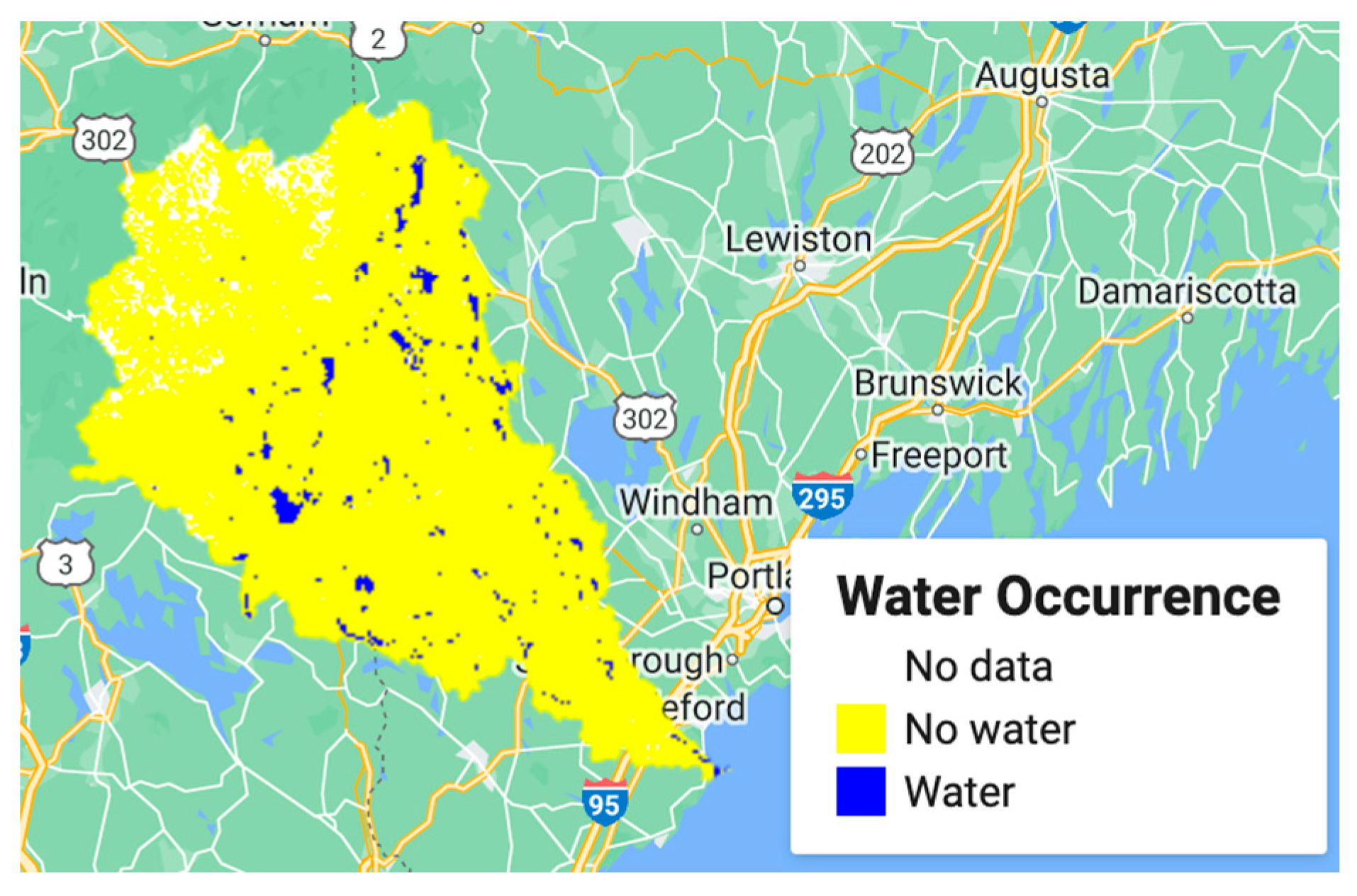
References
- Smith, L.C. Satellite Remote Sensing of River Inundation Area, Stage, and Discharge: A Review. Hydrol. Process. 1997, 11, 1427–1439. [Google Scholar] [CrossRef]
- Loaiza, J.G.; Rangel-Peraza, J.G.; Monjardín-Armenta, S.A.; Bustos-Terrones, Y.A.; Bandala, E.R.; Sanhouse-García, A.J.; Rentería-Guevara, S.A. Surface Water Quality Assessment through Remote Sensing Based on the Box–Cox Transformation and Linear Regression. Water 2023, 15, 2606. [Google Scholar] [CrossRef]
- Zhang, F.; Shao, Y.; Huang, H.; Bahtebay, J. Review of Urban Remote Sensing Research in the Last Two Decades. Acta Ecol. Sin. 2021, 41, 3255–3276. [Google Scholar]
- Wang, Y.; Colby, J.D.; Mulcahy, K.A. An Efficient Method for Mapping Flood Extent in a Coastal Floodplain Using Landsat TM and DEM Data. Int. J. Remote Sens. 2002, 23, 3681–3696. [Google Scholar] [CrossRef]
- Qi, S.; Brown, D.G.; Tian, Q.; Jiang, L.; Zhao, T.; Bergen, K.M. Inundation Extent and Flood Frequency Mapping Using LANDSAT Imagery and Digital Elevation Models. GIScience Remote Sens. 2009, 46, 101–127. [Google Scholar] [CrossRef]
- Grimaldi, S.; Li, Y.; Pauwels, V.R.; Walker, J.P. Remote Sensing-Derived Water Extent and Level to Constrain Hydraulic Flood Forecasting Models: Opportunities and Challenges. Surv. Geophys. 2016, 37, 977–1034. [Google Scholar] [CrossRef]
- Shen, X.; Wang, D.; Mao, K.; Anagnostou, E.; Hong, Y. Inundation Extent Mapping by Synthetic Aperture Radar: A Review. Remote Sens. 2019, 11, 879. [Google Scholar] [CrossRef]
- Shen, X.; Anagnostou, E.N.; Allen, G.H.; Robert Brakenridge, G.; Kettner, A.J. Near-Real-Time Non-Obstructed Flood Inundation Mapping Using Synthetic Aperture Radar. Remote Sens. Environ. 2019, 221, 302–315. [Google Scholar] [CrossRef]
- Yang, Q.; Shen, X.; Anagnostou, E.N.; Mo, C.; Eggleston, J.R.; Kettner, A.J. A High-Resolution Flood Inundation Archive (2016–the Present) from Sentinel-1 SAR Imagery over CONUS. Bull. Am. Meteorol. Soc. 2021, 102, E1064–E1079. [Google Scholar] [CrossRef]
- Short, N.M. The Landsat Tutorial Workbook: Basics of Satellite Remote Sensing; National Aeronautics and Space Administration, Scientific and Technical Information Branch: Washington, DC, USA, 1982. [Google Scholar]
- Jutz, S.; Milagro-Pérez, M.P. Copernicus: The European Earth Observation Programme. Rev. Teledetec. 2020, 56, 5–11. [Google Scholar] [CrossRef]
- Vuolo, F.; Ng, W.-T.; Atzberger, C. Smoothing and Gap-Filling of High Resolution Multi-Spectral Time Series: Example of Landsat Data. Int. J. Appl. Earth Obs. Geoinf. 2017, 57, 202–213. [Google Scholar] [CrossRef]
- Pekel, J.-F.; Cottam, A.; Gorelick, N.; Belward, A.S. High-Resolution Mapping of Global Surface Water and Its Long-Term Changes. Nature 2016, 540, 418–422. [Google Scholar] [CrossRef]
- Walker, J.J.; Soulard, C.E.; Petrakis, R.E. Integrating Stream Gage Data and Landsat Imagery to Complete Time-Series of Surface Water Extents in Central Valley, California. Int. J. Appl. Earth Obs. Geoinf. 2020, 84, 101973. [Google Scholar] [CrossRef]
- Usachev, V.F. Evaluation of Flood Plain Inundations by Remote Sensing Methods. Hydrol. Appl. Remote Sens. Remote Data Transm. 1983, 145, 475–482. [Google Scholar]
- Gleason, C.J.; Smith, L.C. Toward Global Mapping of River Discharge Using Satellite Images and At-Many-Stations Hydraulic Geometry. Proc. Natl. Acad. Sci. USA 2014, 111, 4788–4791. [Google Scholar] [CrossRef] [PubMed]
- Robert Brakenridge, G.; Cohen, S.; Kettner, A.J.; De Groeve, T.; Nghiem, S.V.; Syvitski, J.P.M.; Fekete, B.M. Calibration of Satellite Measurements of River Discharge Using a Global Hydrology Model. J. Hydrol. 2012, 475, 123–136. [Google Scholar] [CrossRef]
- Anh, D.T.L.; Aires, F. River Discharge Estimation Based on Satellite Water Extent and Topography: An Application over the Amazon. J. Hydrometeorol. 2019, 20, 1851–1866. [Google Scholar] [CrossRef]
- Alsdorf, D.E.; Rodríguez, E.; Lettenmaier, D.P. Measuring Surface Water from Space. Rev. Geophys. 2007, 45, RG2002. [Google Scholar] [CrossRef]
- Gorelick, N.; Hancher, M.; Dixon, M.; Ilyushchenko, S.; Thau, D.; Moore, R. Google Earth Engine: Planetary-Scale Geospatial Analysis for Everyone. Remote Sens. Environ. 2017, 202, 18–27. [Google Scholar] [CrossRef]
- Hodson, T.O.; Hariharan, J.A.; Black, S.; Horsburgh, J.S. Dataretrieval 0.1 (Python): A Python Package for Discovering and Retrieving Water Data Available from U.S. Federal Hydrologic Web Services; U.S. Geological Survey Software Release; U.S. Geological Survey: Reston, VA, USA, 2023.
- Vélez, J.I.; Correa, J.C.; Marmolejo-Ramos, F. A New Approach to the Box–Cox Transformation. Front. Appl. Math. Stat. 2015, 1, 12. [Google Scholar] [CrossRef]
- Marquardt, D.W.; Snee, R.D. Ridge Regression in Practice. Am. Stat. 1975, 29, 3–20. [Google Scholar] [CrossRef]
- Tikhonov, A.N. Solution of Incorrectly Formulated Problems and the Regularization Method. Sov. Math. Dokl. 1963, 4, 1035–1038. [Google Scholar]
- Hoerl, A.E.; Kennard, R.W. Ridge Regression: Biased Estimation for Nonorthogonal Problems. Technometrics 1970, 12, 55–67. [Google Scholar] [CrossRef]
- McCuen, R.; Knight, Z.; Cutter, A. Evaluation of the Nash–Sutcliffe Efficiency Index. J. Hydrol. Eng. 2006, 11, 597–602. [Google Scholar] [CrossRef]
- Van Dijk, A.I.J.M.; Brakenridge, G.R.; Kettner, A.J.; Beck, H.E.; De Groeve, T.; Schellekens, J. River Gauging at Global Scale Using Optical and Passive Microwave Remote Sensing. Water Resour. Res. 2016, 52, 6404–6418. [Google Scholar] [CrossRef]
- Delsole, T. A Bayesian Framework for Multimodel Regression. J. Clim. 2007, 20, 2810–2826. [Google Scholar] [CrossRef]
- Peña, M.; Dool, H. van den Consolidation of Multimodel Forecasts by Ridge Regression: Application to Pacific Sea Surface Temperature. J. Clim. 2008, 21, 6521–6538. [Google Scholar] [CrossRef]
- Ranstam, J.; Cook, J.A. LASSO Regression. Br. J. Surg. 2018, 105, 1348. [Google Scholar] [CrossRef]
- van Vliet, M.T.H.; Franssen, W.H.P.; Yearsley, J.R.; Ludwig, F.; Haddeland, I.; Lettenmaier, D.P.; Kabat, P. Global River Discharge and Water Temperature under Climate Change. Glob. Environ. Chang. 2013, 23, 450–464. [Google Scholar] [CrossRef]
- Kousali, M.; Salarijazi, M.; Ghorbani, K. Estimation of Non-Stationary Behavior in Annual and Seasonal Surface Freshwater Volume Discharged into the Gorgan Bay, Iran. Nat. Resour. Res. 2022, 31, 835–847. [Google Scholar] [CrossRef]
- Modabber-Azizi, S.; Salarijazi, M.; Ghorbani, K. A Novel Approach to Recognize the Long-Term Spatial-Temporal Pattern of Dry and Wet Years over Iran. Phys. Chem. Earth Parts ABC 2023, 131, 103426. [Google Scholar] [CrossRef]
- Salarijazi, M.; Ghorbani, K.; Mohammadi, M.; Ahmadianfar, I.; Mohammadrezapour, O.; Naser, M.H.; Yaseen, Z.M. Spatial-Temporal Estimation of Maximum Temperature High Returns Periods for Annual Time Series Considering Stationary/Nonstationary Approaches in Iran Urban Area. Urban Clim. 2023, 49, 101504. [Google Scholar] [CrossRef]
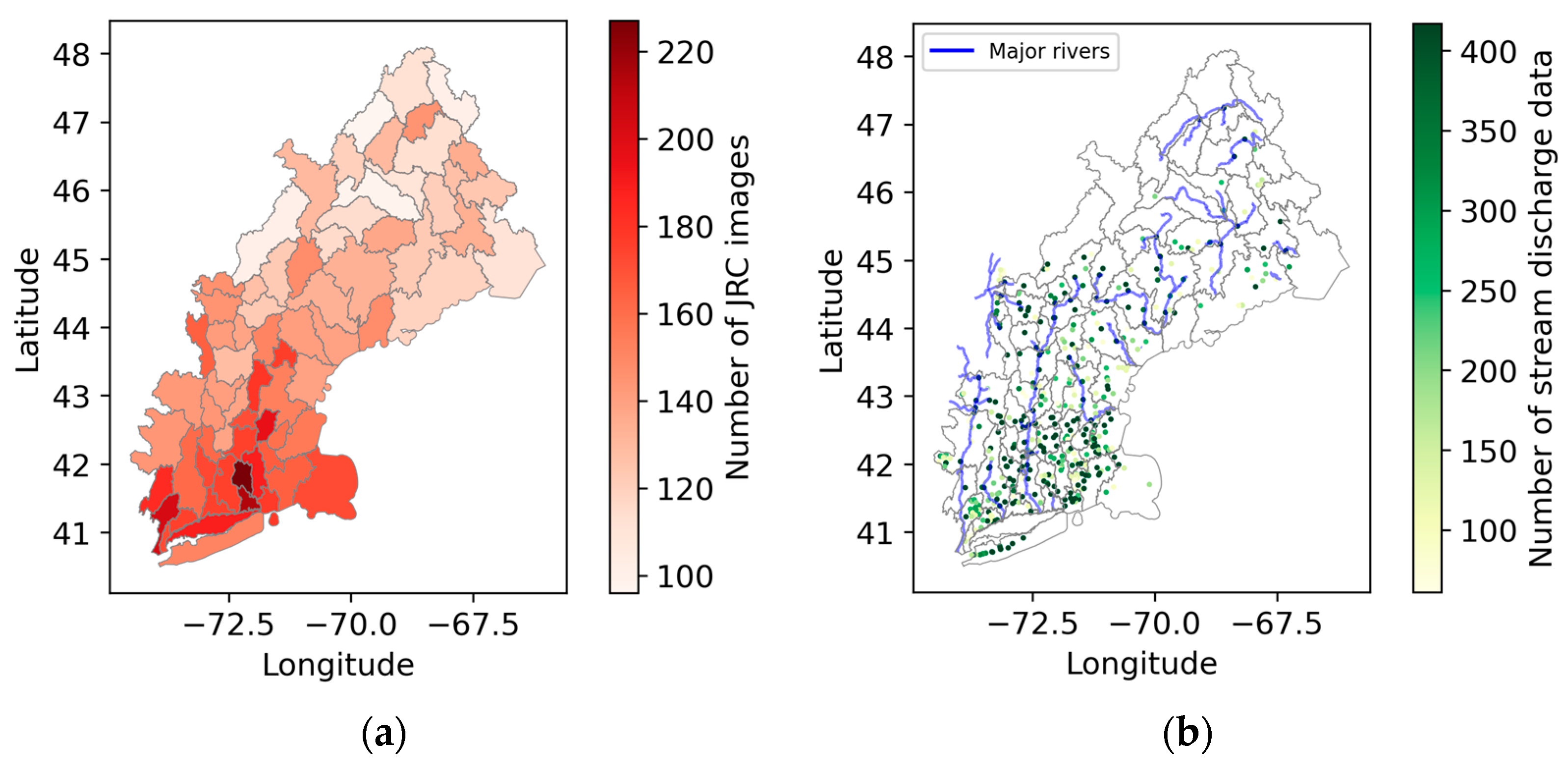
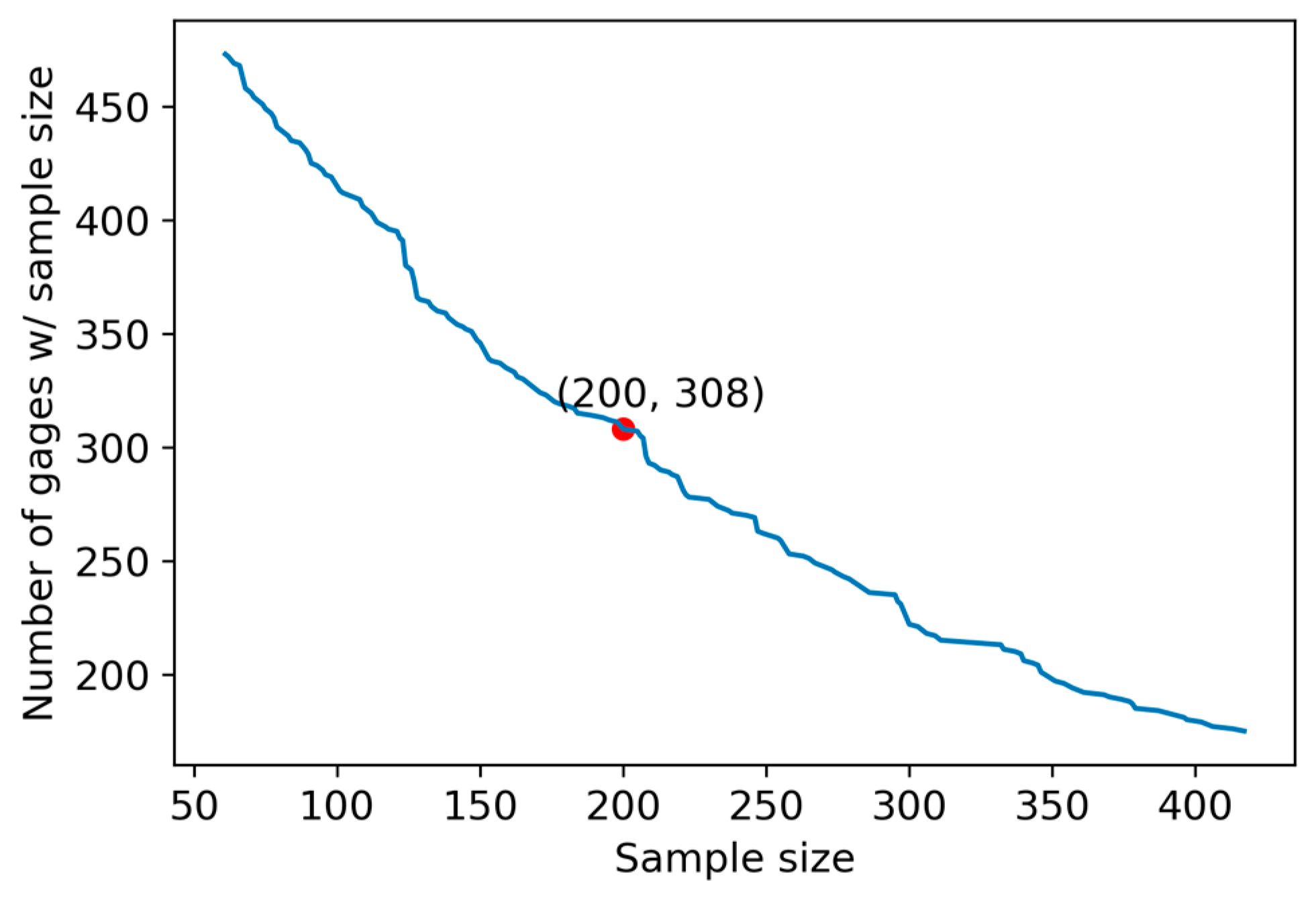

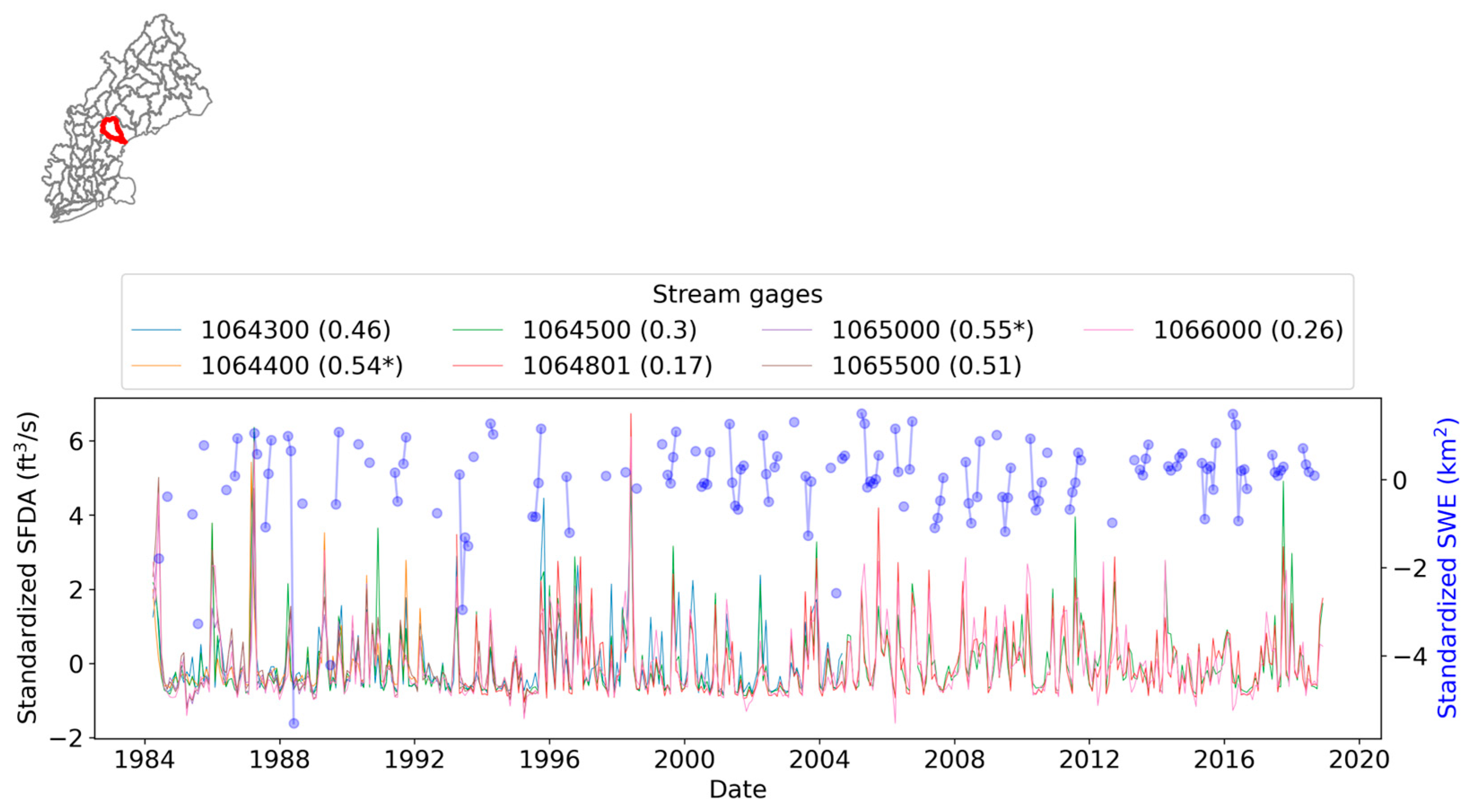
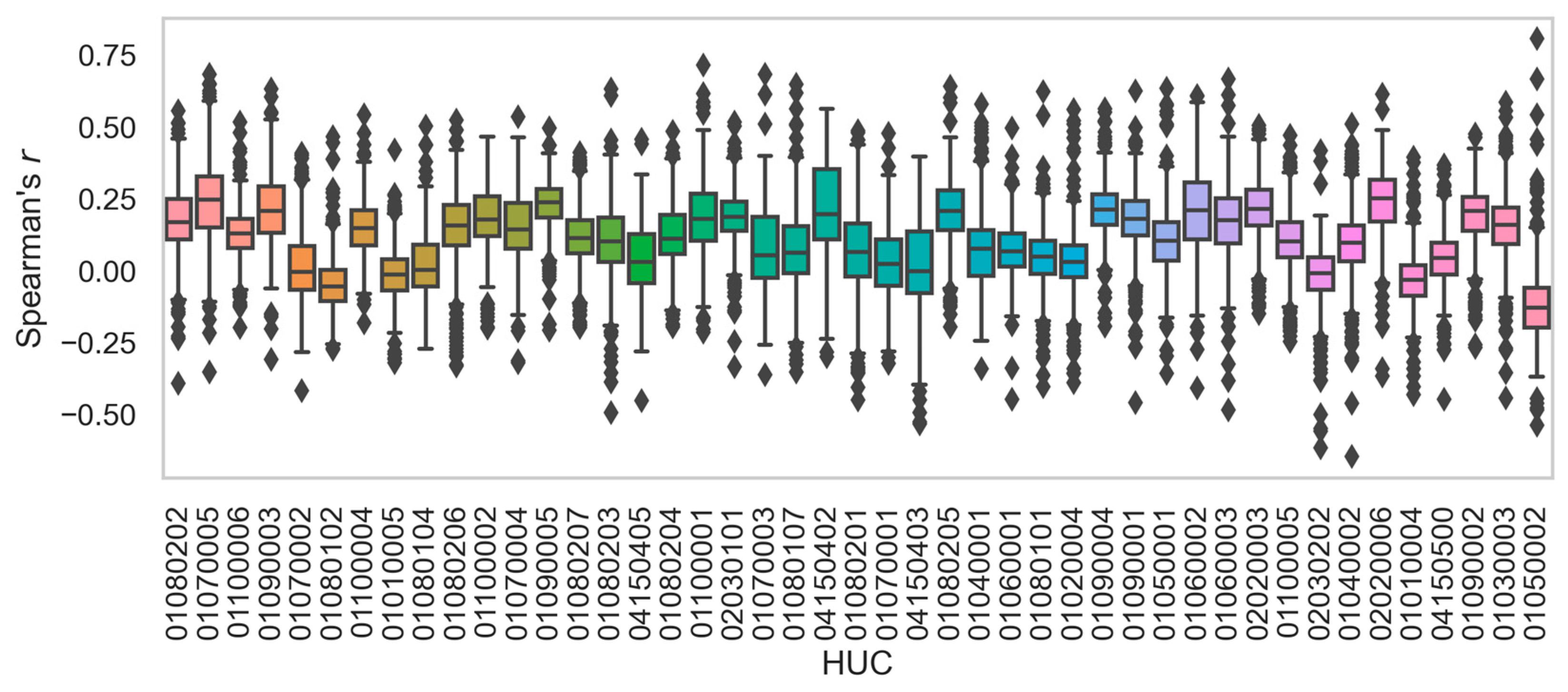
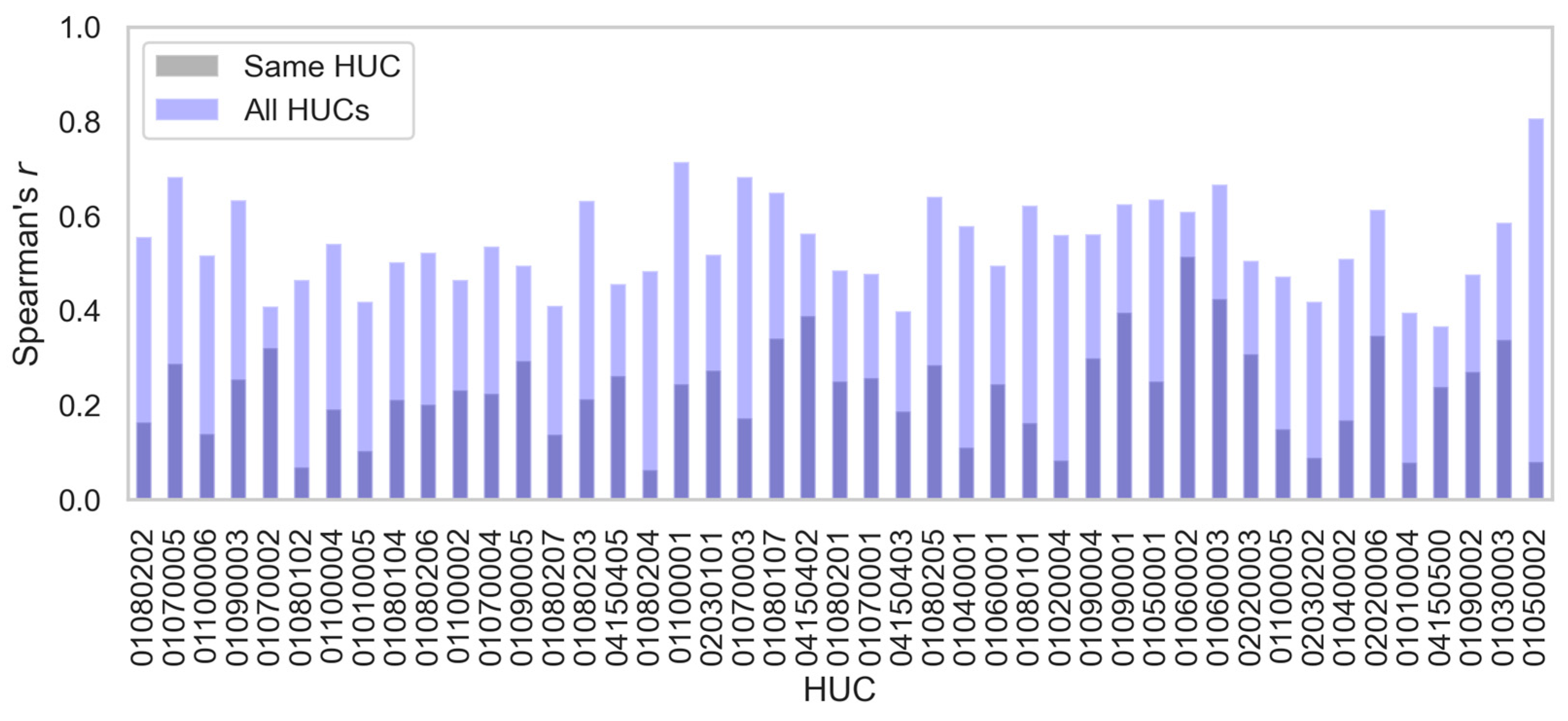

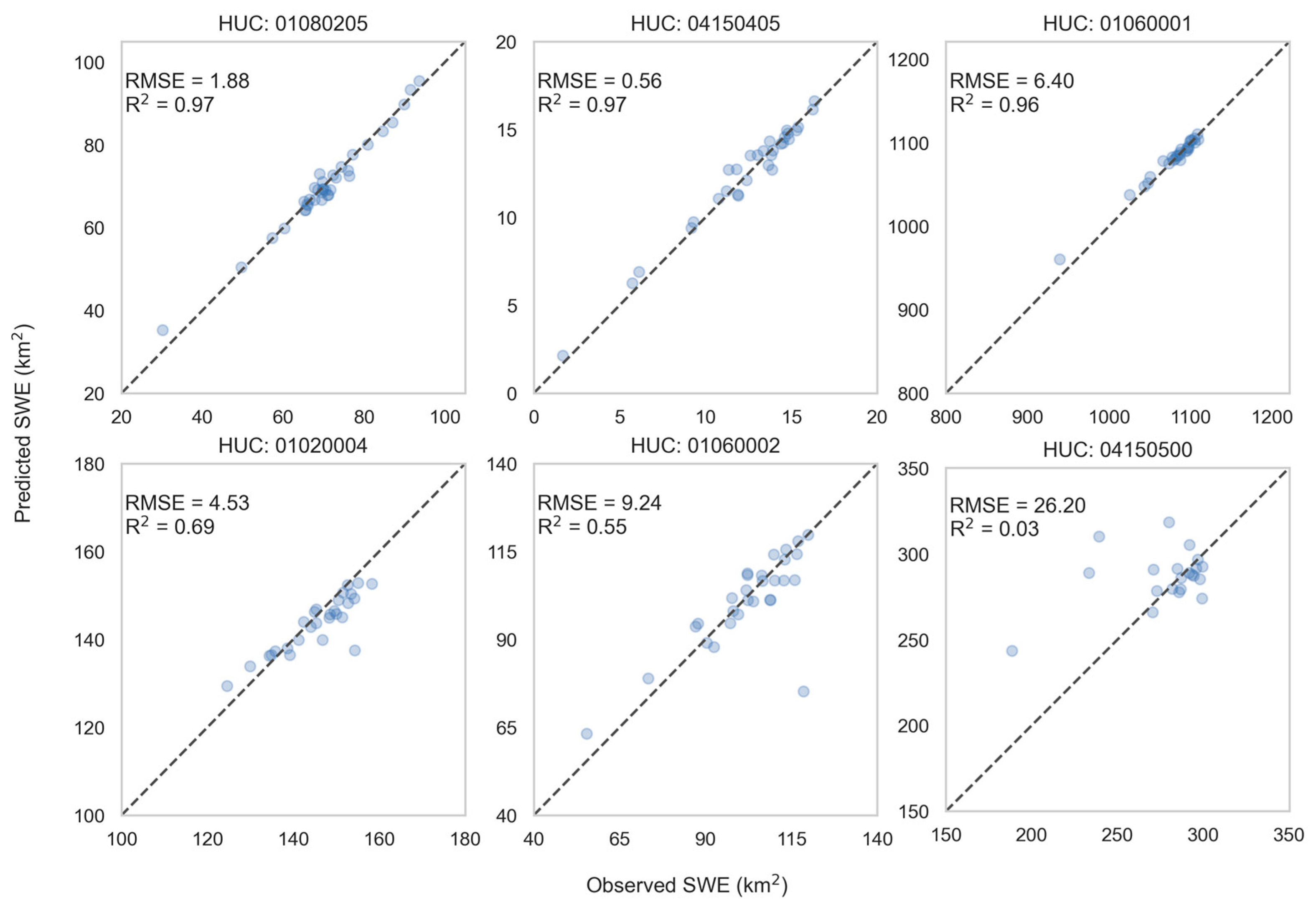

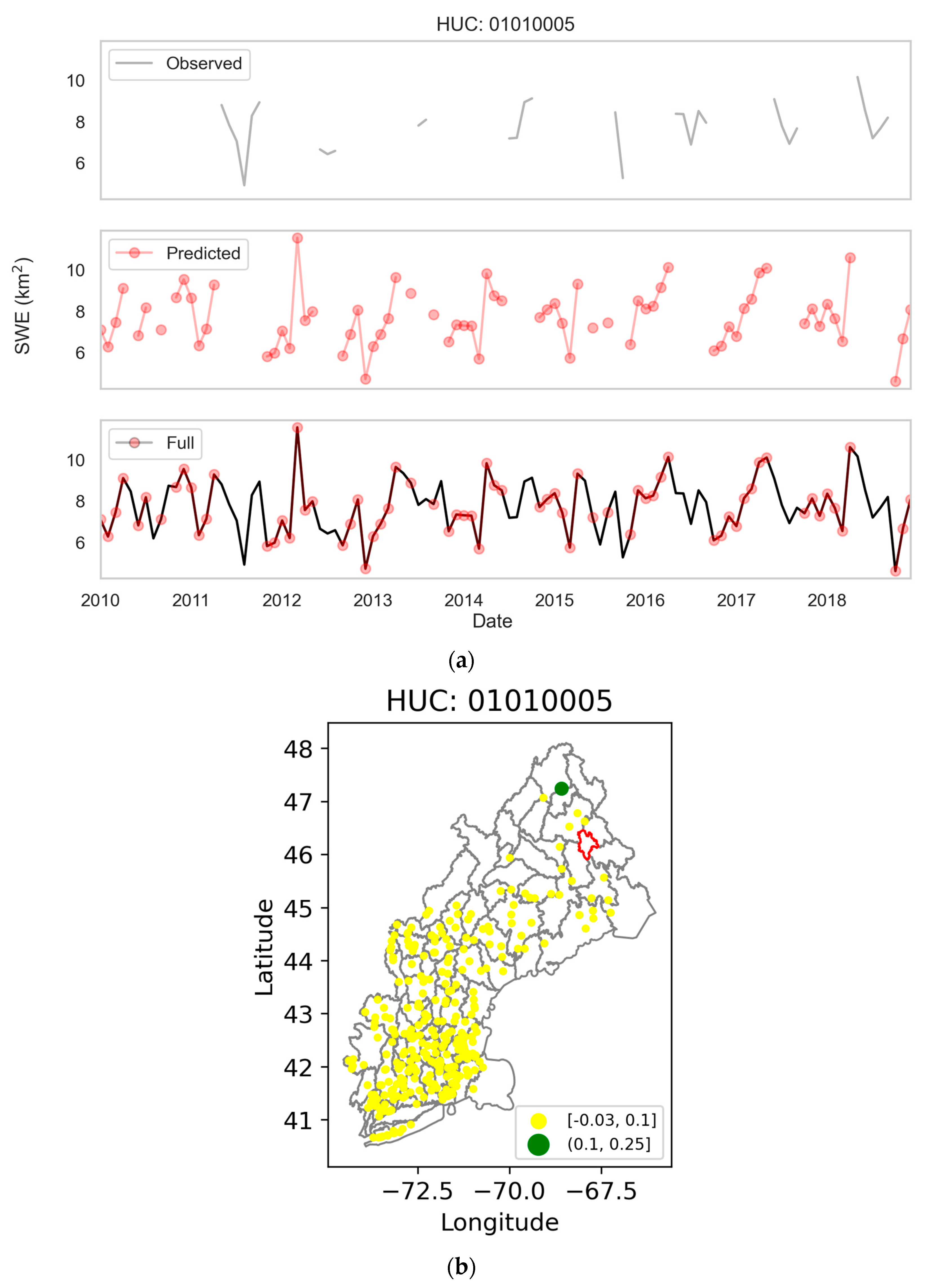
Disclaimer/Publisher’s Note: The statements, opinions and data contained in all publications are solely those of the individual author(s) and contributor(s) and not of MDPI and/or the editor(s). MDPI and/or the editor(s) disclaim responsibility for any injury to people or property resulting from any ideas, methods, instructions or products referred to in the content. |
© 2024 by the authors. Licensee MDPI, Basel, Switzerland. This article is an open access article distributed under the terms and conditions of the Creative Commons Attribution (CC BY) license (https://creativecommons.org/licenses/by/4.0/).
Share and Cite
Yin, Y.; Peña, M. An Imputing Technique for Surface Water Extent Timeseries with Streamflow Discharges. Water 2024, 16, 250. https://doi.org/10.3390/w16020250
Yin Y, Peña M. An Imputing Technique for Surface Water Extent Timeseries with Streamflow Discharges. Water. 2024; 16(2):250. https://doi.org/10.3390/w16020250
Chicago/Turabian StyleYin, Yue, and Malaquias Peña. 2024. "An Imputing Technique for Surface Water Extent Timeseries with Streamflow Discharges" Water 16, no. 2: 250. https://doi.org/10.3390/w16020250
APA StyleYin, Y., & Peña, M. (2024). An Imputing Technique for Surface Water Extent Timeseries with Streamflow Discharges. Water, 16(2), 250. https://doi.org/10.3390/w16020250









